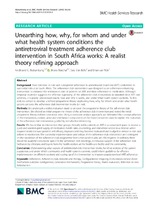| dc.contributor.author | Mukumbang, Ferdinand C. | |
| dc.contributor.author | Marchal, Bruno | |
| dc.contributor.author | Van Belle, Sara | |
| dc.contributor.author | van Wyk, Brian | |
| dc.date.accessioned | 2018-05-15T13:22:08Z | |
| dc.date.available | 2018-05-15T13:22:08Z | |
| dc.date.issued | 2018 | |
| dc.identifier.citation | Mukumbang, F.C. et al. (2018). Unearthing how, why, for whom and under what health system conditions the antiretroviral treatment adherence club intervention in South Africa works: A realist theory refining approach. BMC Health Services Research, 18: 343 | en_US |
| dc.identifier.issn | 1472-6963 | |
| dc.identifier.uri | http://dx.doi.org/10.1186/s12913-018-3150-6 | |
| dc.identifier.uri | http://hdl.handle.net/10566/3674 | |
| dc.description.abstract | BACKGROUND: Poor retention in care and suboptimal adherence to antiretroviral treatment (ART) undermine its
successful rollout in South Africa. The adherence club intervention was designed as an adherence-enhancing
intervention to enhance the retention in care of patients on ART and their adherence to medication. Although
empirical evidence suggests the effective superiority of the adherence club intervention to standard clinic ART care
schemes, it is poorly understood exactly how and why it works, and under what health system contexts. To this
end, we aimed to develop a refined programme theory explicating how, why, for whom and under what health
system contexts the adherence club intervention works (or not).
METHODS: We undertook a realist evaluation study to uncover the programme theory of the adherence club
intervention. We elicited an initial programme theory of the adherence club intervention and tested the initial
programme theory in three contrastive sites. Using a cross-case analysis approach, we delineated the conceptualisation
of the intervention, context, actor and mechanism components of the three contrastive cases to explain the outcomes
of the adherence club intervention, guided by retroductive inferencing.
RESULTS: We found that an intervention that groups clinically stable patients on ART in a convenient space to receive a
quick and uninterrupted supply of medication, health talks, counselling, and immediate access to a clinician when
required works because patients’ self-efficacy improves and they become motivated and nudged to remain in care and
adhere to medication. The successful implementation and rollout of the adherence club intervention are contingent
on the separation of the adherence club programme from other patients who are HIV-negative. In addition, there
should be available convenient space for the adherence club meetings, continuous support of the adherence club
facilitators by clinicians and buy-in from the health workers at the health-care facility and the community.
CONCLUSION: Understanding what aspects of antiretroviral club intervention works, for what sections of the patient
population, and under which community and health systems contexts, could inform guidelines for effective
implementation in different contexts and scaling up of the intervention to improve population-level ART adherence. | en_US |
| dc.language.iso | en | en_US |
| dc.publisher | BioMed Central | en_US |
| dc.rights | © The Author(s). 2018 Open Access This article is distributed under the terms of the Creative Commons Attribution 4.0
International License (http://creativecommons.org/licenses/by/4.0/), which permits unrestricted use, distribution, and
reproduction in any medium, provided you give appropriate credit to the original author(s) and the source, provide a link to
the Creative Commons license, and indicate if changes were made. The Creative Commons Public Domain Dedication waiver
(http://creativecommons.org/publicdomain/zero/1.0/) applies to the data made available in this article, unless otherwise stated. | |
| dc.subject | Adherence | en_US |
| dc.subject | Adherence club | en_US |
| dc.subject | Antiretroviral therapy | en_US |
| dc.subject | Configurational mapping | en_US |
| dc.subject | Intervention-context-Actormechanism- outcome configuration | en_US |
| dc.title | Unearthing how, why, for whom and under what health system conditions the antiretroviral treatment adherence club intervention in South Africa works: A realist theory refining approach | en_US |
| dc.type | Article | en_US |
| dc.privacy.showsubmitter | FALSE | |
| dc.status.ispeerreviewed | TRUE | |

